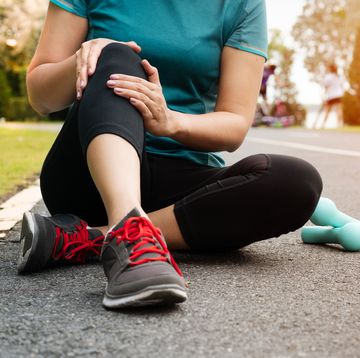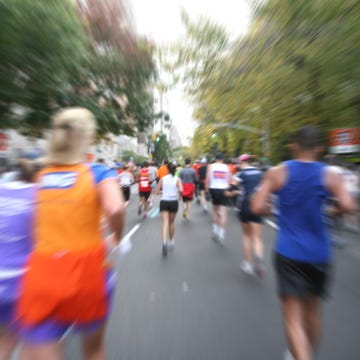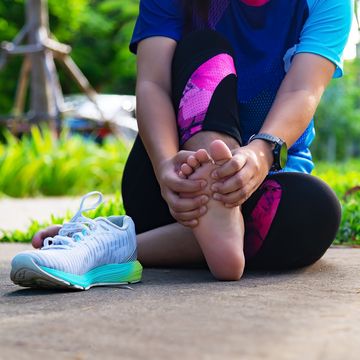Getting your first bruised toenail as a runner is often viewed as a right of passage. But why does this common ailment occur in the first place? And – rather than just accept bruised toenails for what they are – is there anything runners can do to prevent them? We consulted the experts to nail down their top tips on preventing - and healing - bruised toenails.
What exactly is a bruised toenail?
The official medical term for a bruised toenail is subungual haematoma, which means ‘blood under the nail’. This occurs when the blood vessels under the nail are broken. With nowhere to escape, the blood pools. A bruised toenail or several, can be a common sight for runners, particularly among those who train frequently or run long distances.
What everyone's reading
Why is my toenail black?
The dreaded blackened toenail can be the result of several different factors. A combination of repetitive friction, impact, pressure and swelling of the toes can lead to bruised toenails, explains Simone Paul, senior podiatrist and CEO of The Footlift Clinic in London. ‘The feet swell significantly during running and this creates less space in the shoe,’ she explains. ‘As a result, the toes continuously hit the roof of the footwear and rub against each other, and the capillaries are put under pressure.’
Bruising of the nail bed and plate can occur quickly, and results in a toenail that looks black, as the collected blood underneath the nail creates a dark discoloration. Paul warns that runners with congenital and acquired lesser toe deformities such as claw, hammer toe or hallux valgus (bunions) are at a greater risk of developing bruised toenails.
Christophe Champs, an expert in biomechanics and the founder of the PODO Clinic and Workshop, points to a few other factors that can result in bruised toenails. For a start, wearing running socks that are too small or too tight can increase the risk of toenail bruising. So too, can the impact of toes hitting the front of your running shoes, which worsens when running downhill.
On the subject of running shoes, wearing pairs that are either too small or too big can present their own unique problems. It will come as no surprise that running in shoes that are too small will lead to a very unhappy situation, since the cramped foot will suffer additional pressure and repeated friction on the skin and nails. On the other hand, if your running shoes are too big or the toe box is too wide, then the twisting motion of the foot forces your body weight forward and the toes grasp to gain more stability, with the lesser toes curling up. Essentially, according to Champs, when the tip of the toes are in ‘conflict with the footwear’, bruised toenails and blisters can form.
How can I heal a bruised toenail quickly?
Although it might be tempting, avoid attempting invasive treatments on a bruised toenail at home. DIY toenail care can easily lead to infection, so Champs says that it’s best to play it safe. ‘Respect the highest standards of hygiene when clearing and cleaning skin or nail damage, whether it’s bleeding or infected or not,’ he stresses, adding that if you have any concerns regarding the skin and nail damage, consult a healthcare professional.
Keeping the nail clean and dry is crucial. Paul advises drying any bruised toenails after a bath or shower by pressing lightly on the area with a towel. Then use a tissue to reduce moisture in the bruise, and to prevent fungal infections . Moisture present in the nail bed will increase the chance of the nail thickening (onychauxis), she says.
Paul also advises that you protect any bruised toenails with a sterile dressing while walking, as this will reduce tenderness and further bruising to the nail plate.
How long do bruised toenails last?
The healing time of a bruised toenail varies depending on several factors, such as how quickly your nails grow and the severity of the damage, explains Champs. If a bruised toenail falls off, it’s important to keep the area covered during physical activity, but to allow the area to breathe at night in a very clean environment. ‘Patience is key – just keep the area dry and clean at all times,’ Champs advises.
On average, though, you’re looking at a healing period lasting weeks to months, says Paul. For the big toe, which contains more capillaries, the bruising of the toenail may last six to eight months – and, in some cases, it can take over a year to grow out. For the other toes, it can take up to three months for toenails to heal.
Should I adapt my running while a bruised toenail heals?
There are a few things Paul recommends changing up if you’re keen to run with a bruised toenail. She recommends, if possible, wearing running shoes that are half a size bigger, and covering the bruised nail with a plaster. Running on terrain which will reduce the impact, such as grass or astroturf can also be helpful. Since your feet will swell – which could aggravate the injury – both Paul and Champs advise doing shorter runs during the healing period.
Champs also suggests the following tips if your set on running with a bruised toenail:
- Wear running socks that aren’t too tight, have no seams over the bruised area, and can be pulled forward after you put them on.
- Check the size of your running shoes and make sure you don’t look for the position of your big toe with your thumb if your second toe is longer.
- Keep your toenails short and square cut to prevent them from catching on socks or conflicting with your shoes, and smoothen the corners with a glass file to avoid any ingrown toenails.
- Last but not least, avoid running downhill.
If the bruised toenail becomes painful, it is best to stop running and seek advice from a healthcare professional.
How can runners prevent bruised toenails?
In addition to keeping toenails trimmed and filed, there are several other preventative measures runners can take to avoid toenail bruising, says Paul. Her recommendations include using deeper and wider running shoes, plus split-toe compression socks to prevent swelling and friction to the nail plates.
Champs also suggests a specific lacing technique, the runner’s loop lacing method. This helps to secure the foot more effectively and minimises movement inside the shoe.
‘This method is a game changer if you tend to run downhill,’ he says. ‘It holds the foot from sliding forward in the shoes and prevents the toes from hitting the firm and protective tip of the shoe. But, before using the top eyelets of the footwear to secure the heel, you can also re-lace your shoes completely by taking one lace from the top medial eyelet (the medial side of your ankle) to the last lateral eyelet (near your fifth toe). Then, cross horizontally towards the first toe and cross this lace only, all the way up. Because you started from the second eyelet at the top, you will still be able to do the runner’s loop. It’s a great combo to avoid any excessive traction on the big toenail when tightening your shoelaces.’













